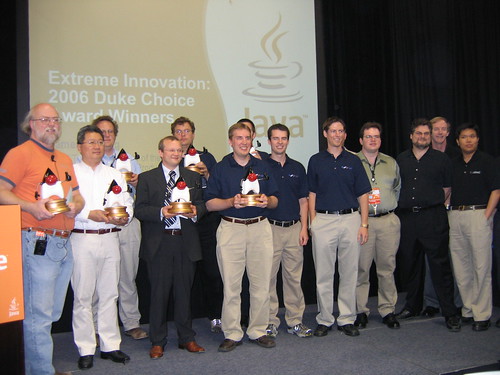I've been quite busy of late: a nearby Tapestry 4 project to pay the bills, a bunch of chances to talk to crowds about Tapestry 5 (in Philadelphia, Minneapolis and at home in Portland, Oregon).
I've significantly changed my Tapestry 4 presentation; it now highlights the BeanForm component, then the Table component and lastly Trails. I'm showing the high end of what's possible in Tapestry, rather than showing people the gory little details up front. That usually gets their attention.
I then show what's going on in Tapestry 5 and that really get's peoples jaws dropping. People crave this. They want to use it today. That is the desired effect. Case-insensitive, pretty URLs. Live class reloading. No XML. Incredible performance. Best of breed exception reporting. And we've barely gotten started yet.
I've been busy: Guice has set a high bar for IoC containers, but it still doesn't have certain features that Tapestry is dependent upon. That hasn't slowed me from taking the best ideas from it. Tapestry 5 now has a similar approach to autobuilding, and in most cases, a Tapestry service no longer needs a service builder method. Instead, a module can define a static bind() method and use the ServiceBinder to tell Tapestry about service interfaces and service implementations: Here's an example from the Tapestry module itself:
public static void bind(ServiceBinder binder)
{
binder.bind(ClasspathAssetAliasManager.class, ClasspathAssetAliasManagerImpl.class);
binder.bind(PersistentLocale.class, PersistentLocaleImpl.class);
binder.bind(ApplicationStateManager.class, ApplicationStateManagerImpl.class);
binder.bind(
ApplicationStatePersistenceStrategySource.class,
ApplicationStatePersistenceStrategySourceImpl.class);
binder.bind(BindingSource.class, BindingSourceImpl.class);
binder.bind(TranslatorSource.class, TranslatorSourceImpl.class);
binder.bind(PersistentFieldManager.class, PersistentFieldManagerImpl.class);
binder.bind(FieldValidatorSource.class, FieldValidatorSourceImpl.class);
binder.bind(ApplicationGlobals.class, ApplicationGlobalsImpl.class);
binder.bind(AssetSource.class, AssetSourceImpl.class);
binder.bind(Cookies.class, CookiesImpl.class);
binder.bind(Environment.class, EnvironmentImpl.class);
binder.bind(FieldValidatorDefaultSource.class, FieldValidatorDefaultSourceImpl.class);
binder.bind(RequestGlobals.class, RequestGlobalsImpl.class);
binder.bind(ResourceDigestGenerator.class, ResourceDigestGeneratorImpl.class);
binder.bind(ValidationConstraintGenerator.class, ValidationConstraintGeneratorImpl.class);
binder.bind(EnvironmentalShadowBuilder.class, EnvironmentalShadowBuilderImpl.class);
binder.bind(ComponentSource.class, ComponentSourceImpl.class);
binder.bind(BeanModelSource.class, BeanModelSourceImpl.class);
}
The ServiceBinder interface is fluent, we could follow on with .withScope(), .withId() or .eagerLoad() if we wanted. In most cases, defaults from there are sensible or come from annotations on the implementation class (and therefore, rarely need to be overridden).
The primary mechanism for injection is via constructor parameters. In general, annotations are not necessary on those parameters any more, and Tapestry will find the correct object or service automatically (primarily by matching on parameter type).
Service builder methods are still useful for when a service involves more than just instantiating a class, such as registering it for some kind of notification from another service:
public ComponentClassResolver buildComponentClassResolver(ServiceResources resources)
{
ComponentClassResolverImpl service = resources.autobuild(ComponentClassResolverImpl.class);
// Allow the resolver to clean its cache when the source is invalidated
_componentInstantiatorSource.addInvalidationListener(service);
return service;
}
The autobuild() method will construct an instance, performing necessary injections. We can then perform any additional realization before returning it.
The end result has been to simplify and minimize the amount of code in the module builder classes.
Tapestry IoC now supports services that do not have a service interface; the actual type is used as the service interface and the service is not proxied: it is created on first reference and can't have interceptors. Normal services are proxied on first reference, and only realized (converted into a full service with a core service implementation and interceptors) on first use (the first method call).
In a step away from the code, we are running a vote to add Dan Gredler as a Tapestry committer. I expect that to run successfully, and I also expect to add a few more people to the roles soon.
I'm getting very excited. Things are coming together nicely (but never fast enough).
 Warner Onstine's book on Tapestry 4:
Warner Onstine's book on Tapestry 4: 


 I just got back from ApacheCon 2006, which was a fun time. I got a chance to talk Tapestry with members of the Shale team and with a few Tapestry users; I even demoed some of the new Tapestry 5 features (resulting in a few dropped jaws). Catch me at The Ajax Experience for more of the same! I also got a bunch of speakers hooked on the
I just got back from ApacheCon 2006, which was a fun time. I got a chance to talk Tapestry with members of the Shale team and with a few Tapestry users; I even demoed some of the new Tapestry 5 features (resulting in a few dropped jaws). Catch me at The Ajax Experience for more of the same! I also got a bunch of speakers hooked on the 

